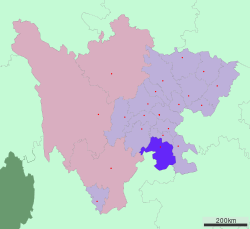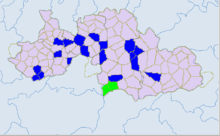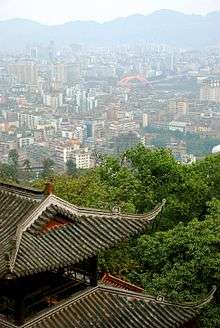Yibin
| Yibin 宜宾市 | |
|---|---|
| Prefecture-level city | |
 Location of Yibin City (jurisdiction) in Sichuan | |
 Yibin Location in China | |
| Coordinates: 28°46′N 104°37′E / 28.767°N 104.617°ECoordinates: 28°46′N 104°37′E / 28.767°N 104.617°E | |
| Country | People's Republic of China |
| Province | Sichuan |
| Area | |
| • Prefecture-level city | 13,293.89 km2 (5,132.80 sq mi) |
| • Urban | 1,131 km2 (437 sq mi) |
| • Metro | 1,131 km2 (437 sq mi) |
| Elevation | 321 m (1,053 ft) |
| Population (2010 census)[1] | |
| • Prefecture-level city | 4,471,896 |
| • Density | 340/km2 (870/sq mi) |
| • Urban | 836,340 |
| • Urban density | 740/km2 (1,900/sq mi) |
| • Metro | 836,340 |
| • Metro density | 740/km2 (1,900/sq mi) |
| Time zone | China Standard (UTC+8) |
| Postal code | 644000 |
| Area code(s) | 0831 |
| Licence Plate Prefix | 川Q |
| Website |
yibin |
Yibin (simplified Chinese: 宜宾; traditional Chinese: 宜賓; Sichuanese Pinyin: ȵi2bin1; Sichuanese pronunciation: [ɲi˨˩pin˥]; pinyin: Yíbīn; Wade–Giles: I-pin) is a prefecture-level city in the southeastern part of Sichuan province, People's Republic of China, located at the junction of the Min and Yangtze Rivers.
Its population was 4,471,840 inhabitants according to the 2010 census of whom 836,340 lived in the built-up (or metro) area made of Cuiping District. One can notice that Yibin County is being conurbated soon as urbanisation sprawls in the southwestern direction.
History
Human habitation of Yibin dates back at least 4,000 years. Yibin was established as a county in the Han dynasty (206 BC − AD 220). Under the Ming and Qing, the town and its hinterland was known as Xuzhou Commandery (t 敘州府, s 叙州府, p Xùzhōufǔ), which was variously romanized as Suifu, Suifoo, and Suchow.[2] Its population around 1907 was estimated at 50,000.[3]
Geography

Yibin is located in the southeast portion of Sichuan at the southern end of the Sichuan Basin, bordering Zhaotong (Yunnan) to the south, Luzhou to the east, Liangshan Yi Autonomous Prefecture and Leshan to the west, and Zigong to the north, and has a total area is 13,283 square kilometres (5,129 sq mi). The city ranges in latitude from 27° 50'−29° 16' N, and in longitude from 103° 36'−105° 20' E, stretching 153 km (95 mi) east-west and 150 km (93 mi) north-south.
The city is located at the confluence of the Min and Yangtze Rivers. Above Yibin, the Yangtze is also known as the Jinsha River. Below Yibin, the Yangtze is known in Chinese as the Chang Jiang or "Long River."
As with the rest of the Sichuan Basin, Yibin has a monsoon-influenced humid subtropical climate (Köppen Cwa) with high humidity year-round; winters are short and mild while summers long, hot, and humid. The monthly 24-hour average temperature ranges from 7.8 °C (46.0 °F) in January to 26.6 °C (79.9 °F) in July and August; the annual mean is 17.80 °C (64.0 °F). Despite its location in the Yangtze River valley, it is still 1.5 to 2.0 °C (2.7 to 3.6 °F) cooler than Chongqing, located further downstream, in its warmest months. Frost is uncommon and the frost-free period lasts 347 days.[4] Rainfall is common year-round but is the greatest in July and August, with very little of it in the cooler months. With monthly percent possible sunshine ranging from 10% in December and January to 42% in August, the city receives only 1,018 hours of bright sunshine annually; Yibin has one of the lowest annual sunshine totals nationally, lower than even nearby Chengdu and Chongqing. Spring (March–April) tends to be sunnier and warmer in the day than autumn (October–November).
| Climate data for Yibin (1971−2000) | |||||||||||||
|---|---|---|---|---|---|---|---|---|---|---|---|---|---|
| Month | Jan | Feb | Mar | Apr | May | Jun | Jul | Aug | Sep | Oct | Nov | Dec | Year |
| Record high °C (°F) | 18.5 (65.3) |
23.7 (74.7) |
31.0 (87.8) |
34.7 (94.5) |
37.1 (98.8) |
36.1 (97) |
37.9 (100.2) |
39.5 (103.1) |
38.3 (100.9) |
30.4 (86.7) |
26.8 (80.2) |
20.2 (68.4) |
39.5 (103.1) |
| Average high °C (°F) | 10.5 (50.9) |
12.5 (54.5) |
17.5 (63.5) |
23.2 (73.8) |
26.9 (80.4) |
28.9 (84) |
31.2 (88.2) |
31.5 (88.7) |
26.5 (79.7) |
21.5 (70.7) |
17.0 (62.6) |
11.9 (53.4) |
21.6 (70.9) |
| Daily mean °C (°F) | 7.8 (46) |
9.4 (48.9) |
13.6 (56.5) |
18.6 (65.5) |
22.3 (72.1) |
24.5 (76.1) |
26.6 (79.9) |
26.6 (79.9) |
22.6 (72.7) |
18.3 (64.9) |
14.0 (57.2) |
9.3 (48.7) |
17.8 (64.03) |
| Average low °C (°F) | 5.9 (42.6) |
7.4 (45.3) |
10.9 (51.6) |
15.3 (59.5) |
19.0 (66.2) |
21.5 (70.7) |
23.4 (74.1) |
23.3 (73.9) |
20.1 (68.2) |
16.2 (61.2) |
12.0 (53.6) |
7.5 (45.5) |
15.2 (59.4) |
| Record low °C (°F) | −1.7 (28.9) |
−0.2 (31.6) |
1.1 (34) |
5.4 (41.7) |
10.3 (50.5) |
16.0 (60.8) |
18.0 (64.4) |
17.8 (64) |
14.5 (58.1) |
5.9 (42.6) |
3.4 (38.1) |
−1.4 (29.5) |
−1.7 (28.9) |
| Average precipitation mm (inches) | 19.6 (0.772) |
26.3 (1.035) |
32.7 (1.287) |
60.2 (2.37) |
110.5 (4.35) |
161.7 (6.366) |
228.7 (9.004) |
188.4 (7.417) |
119.5 (4.705) |
64.4 (2.535) |
33.3 (1.311) |
17.8 (0.701) |
1,063.1 (41.853) |
| Average precipitation days (≥ 0.1 mm) | 11.2 | 12.5 | 13.2 | 14.1 | 16.3 | 17.1 | 14.7 | 13.4 | 16.3 | 16.6 | 12.0 | 10.5 | 167.9 |
| Average relative humidity (%) | 85 | 83 | 79 | 76 | 76 | 81 | 82 | 80 | 83 | 85 | 84 | 85 | 81.6 |
| Mean monthly sunshine hours | 32.1 | 39.6 | 78.5 | 116.0 | 116.9 | 107.7 | 147.2 | 169.0 | 81.6 | 53.1 | 45.8 | 30.7 | 1,018.2 |
| Percent possible sunshine | 10 | 13 | 21 | 30 | 28 | 26 | 35 | 42 | 22 | 15 | 14 | 10 | 23 |
| Source #1: China Meteorological Administration | |||||||||||||
| Source #2: Weather China | |||||||||||||
Administrative divisions

| Map | |||||
|---|---|---|---|---|---|
| Name | Hanzi | Hanyu Pinyin | Population (2004 est.) | Area (km²) | Density (/km²) |
| Cuiping District | 翠屏区 | Cuìpíng Qū | 780,000 | 1,123 | 695 |
| Nanxi District | 南溪区 | Nánxī Qū | 410,000 | 704 | 582 |
| Yibin County | 宜宾县 | Yíbīn Xiàn | 980,000 | 3,034 | 323 |
| Jiang'an County | 江安县 | Jiāng'ān Xiàn | 540,000 | 910 | 593 |
| Changning County | 长宁县 | Chángníng Xiàn | 430,000 | 975 | 441 |
| Gao County | 高县 | Gāo Xiàn | 500,000 | 1,323 | 378 |
| Junlian County | 筠连县 | Jūnlián Xiàn | 390,000 | 1,254 | 311 |
| Gong County | 珙县 | Gǒng Xiàn | 420,000 | 1,150 | 365 |
| Xingwen County | 兴文县 | Xīngwén Xiàn | 440,000 | 1,373 | 320 |
| Pingshan County | 屏山县 | Píngshān Xiàn | 290,000 | 1,437 | 202 |

Economy
The city's industry focuses on electronics, food products, and power generation. It also produces paper, silk, and leather products. The surrounding region is rich in agricultural resources, growing rice, barley, oil seeds, sesame, and tea.
The largest employer in Yibin is Wuliangye, a company best known for Wuliangye, a brand of sorghum-based distilled spirits known as baijiu. The Wuliangye Group grew from a small company employing just 300 people in 1977 into a large company employing over 20,000 on a seven square kilometer plant. According to an August 2005 article in a securities weekly, the Wuliangye Group is 72% state owned and provides 70% of the revenues of Yibin City, a major regional center at the head of the Yangtze in southeastern Sichuan. In 2004 6,225 retired military worked for the company, out of a total work force of over 20,000. One third of top management positions are held by retired members of the military.[5] Unsuccessful efforts to diversify its business, poor transparency and a murky ownership pictures are among the company's problems today.[6] However, liquor is not the sole product of the WuLiangye Group. It also provides the specialized high-tech anti-counterfeit packaging and printing business and engineering services. Wuliangye now contributes about 60% of Yibin's GDP.
Transportation
The region's natural waterways provide transportation links with the surrounding area, and Yibin is also connected to Chongqing and Chengdu by rail and express highway. Yibin's proximity to the Yunnan and Guizhou borders also means that transportation to the provinces is available by rail and by bus.
Yibin has three bridges over the Chang Jiang section of the Yangtze and ten bridges over the Jinsha.
Yibin Airport offers flights to Beijing, Guangzhou, Guiyang, Hangzhou, Kunming, Lhasa, Sanya, Shanghai, Shenzhen, Xi'an, and Yichang.
Tourism
There are several hot springs near Yibin, plus many other tourist attractions. Such attractions include the Bamboo Sea in Changning County and the Xingwen Stone Forest. Cuiping mountain in the centre of the city provides wonderful views of Yibin. Yibin is also the confluence of the Min and Jinsha Rivers, which together form the Chang Jiang as the Yangtze River is known in Chinese from Yibin to Shanghai.
The most significant scenic resource is Mountain Park (dashan gongyuan,大山公园), which stretches for hundreds of kilometers.
References
Citations
- ↑ "China: Administrative Division of Sìchuān / 四川省". citypopulation.de.
- ↑ EB (1887).
- ↑ EB (1911).
- ↑ "宜宾 - 气象数据 -中国天气网". weather.com.cn.
- ↑ "An Army of Production Out of Uniform: Retired Soldiers at Wuliangye", PLA Daily July 29, 2004
- ↑ "Stockholder Interests Poorly Represented, This is How Profits Slip Away," Bond Market Weekly, August 22, 2005
Bibliography
- "Su-chow", Encyclopædia Britannica, 9th ed., Vol. XXII, New York: Charles Scribner's Sons, 1887, p. 617.
- "Su-chow", Encyclopædia Britannica, 11th ed., Vol. XXVI, Cambridge: Cambridge University Press, 1911, p. 7.
External links
- Official city website
- Unofficial city briefing of Yibin
- Yibin City on bashu.net
- Yibin on chinaculture.org
